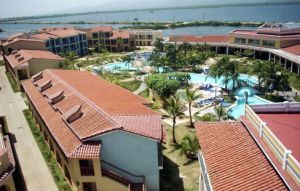 When a new hotel for the Ancon peninsula, in the southern Cuban village, was demanded, designers found the most Solomonic solution in transplanting a replica of Trinidad right in the very shores of the beach.
When a new hotel for the Ancon peninsula, in the southern Cuban village, was demanded, designers found the most Solomonic solution in transplanting a replica of Trinidad right in the very shores of the beach.
After a decade of operation (founded in 2001), the Hotel Brisas Trinidad del Mar, belonging to the Cubanacan chain, preserves, more than the sui generis charm granted by its colonial appearance and its strategic position next to one of the best beaches on the south coast of Cuba.
In that way, arches, balustrades, windows, courtyards, squares and even a bell tower shadowing the viewpoints of the time, overlap in Sancti Spiritus tourist facility, which has 241 rooms spread over seven blocks of three levels of height, as well as systems for swimming pools, restaurants, bars, cafes and other spaces designed exclusively for recreation.
“In terms of money, works and worries, the maintenance of the hotel becomes a difficult task,” says young Alderlayse Llanes, deputy general manager of the property, one of the three that are integrated under a single administration in the south of Trinidad’s city (the other two are the Ancon and the Costa Sur).
MAINTAINING THE HOTEL
The young bartender Luis Manuel Simon could not believe his eyes when looking at a June morning in 2005 and he found their workplace turned into a pile of rubble, reduced to shattered glassware, the tableware mixed with the furniture, a tile stuck in the belly of a palm garden, the most obvious sign of the wrath of Hurricane Dennis.
The cyclone devastated much of southern Sancti Spiritus, interrupted the water supply and cut off power for 15 days to the region, but for workers in Trinidad del Mar it also left a moral: when there is capacity to respond, no hit is mortal as hard as it may seem.
Of that stroke, tha facility emerged strengthened, especially the maintenance strategy, which now holds the property in its founding vigor and ensures it as an emblematic site of tourism in south-central Cuba.
The conservation policy, endorsed in the Guidelines adopted at the Sixth Congress of the Cuban Communist Party (PCC, for its Spanish acronym), is translated here as the art of taking care of a corner everyday, a formula, which according to its directors, it’s the only way to keep the hotel like new.
The redecoration of all the restaurants, the replacement of air conditioners, the improvement of lingerie and other resources and equipment in the 100% of the rooms and the progressive rehabilitation of these are the most visible fronts of a strategy in which the hotel helps itself, both its own brigade, and of other specialized forces.
After having suffered from the chronic drought that plagued the region and also from the damages to the electric service in the past, the hotel has learned to save water without lacerating its performance and the energy consumption remains below plan, mainly from a holding a rational operation of the equipment and the compaction of areas and offers in the low season.
ON A GLASS PENINSULA
To raise Trinidad del Mar was necessary first to borrow the land to nature, to build the causeway Bay of Casilda and then, between this and the natural projection of Ancon, remove thousands of tons of silt and create a large artificial platform on which today sits the picturesque facility.
Existing on an ecosystem as fragile as this- a glass peninsula, exaggerate some of the specialists- demands the hotel to comply with several environmental regulations, a practice that according to its top executives fortunately has taken root among workers and guests who attend the site daily.
“We have assembled a system of environmental management, says the deputy director general, which includes systematic training of the staff and additional requirements which are also controlled by the Ministry of Science, Technology and Environment (CITMA).”
The classification of waste in line with current regulations, the use of less packaging products, the coordination with the Raw Materials Enterprise to recycle all the necessary and the controls to get to know the noise levels are required assumptions governing the overall performance of the property.
NO FEAR OF COMPETITION
The attraction of Trinidad and its Sugar Mill Valley, recognized by UNESCO as Cultural Heritage of Humanity, the nearby mountain range Guamuhaya, with admirable trails and the bounties of the southern beaches form a triangle of privileges, which translate in the hotel keeping up to a 95 percent occupancy in the high season.
Alderlayse Llanes confesses that he does not fear competition from over the 600 hostels settled in the city of Trinidad because after all “every visitor knows what he or she wants, that tourism in family homes is one thing and this is other, they rather complement. “
Trinidad del Mar boasts the collective stability of just over 180 workers, that stretches upward to 250 in the high season, and who, according to them, have learned to cope both with the circuit tourism and with the long-stay.
The hotel has been experiencing the purchase of fruits and vegetables directly to peasant producers in the area, an approach that according to Eduardo Marin, head of supply of the hotel, has brought gains for both parties and promises an immediate growth.
Among its most pressing debts, the directors of Trinidad del Mar recognize the need to continue raising the quality of service and the overall performance of the group, which are the best chances of success in a competition where not only the sun, sand and architecture with colonial style count.
[nggallery id=28]
 Escambray ENGLISH EDITION
Escambray ENGLISH EDITION





Helpful information. Lucky me I found your website unintentionally, and I am stunned why this coincidence didn’t came about in advance! I bookmarked it.